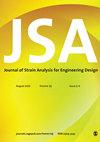单轴和多轴循环载荷下裂纹轴疲劳寿命预测I-III型三维应力强度因子的无网格估算方法评价与优化
IF 1.4
4区 工程技术
Q3 ENGINEERING, MECHANICAL
Journal of Strain Analysis for Engineering Design
Pub Date : 2023-01-12
DOI:10.1177/03093247221142661
引用次数: 0
摘要
在本研究中,为了估算裂纹轴在不同循环载荷下I-III模式下的三维应力强度因子、疲劳裂纹扩展和疲劳寿命预测,对无网格方法进行了评估,并选择了最合适的方法。为了获得更好的结果,首先确定基本函数(bf),并对它们的性能和效率进行比较。此外,在对所有方法中的bf进行充实,并研究增加多项式- bf (m = 4,7,10)及其线性或二次性的句子数对计算精度的影响的同时,在MQ-RPIM和EXP-RPIM方法中使用了两组扩展-充实的rbf,即多重二次型rbf和高斯rbf。为了优化RPIM方法中的形状参数,确定MLPG方法中的惩罚因子,采用单目标和多目标粒子群算法。然后,选取具有初始半椭圆表面裂纹的轴作为离散弱微分方程的三维无网格域,在固定纬度的拉伸、弯曲和扭转循环载荷下进行建模。利用PSO算法改变形状参数的标准值并估计其最优值,并与实验、MLPG、PIM、FEM和XFEM方法的计算结果进行比较,得到了应用方法计算的最佳答案;位移场、应变场和应力场,以及I-III型的SIFs。最后,在单轴循环荷载分析结果的基础上,选择MQ-RPIM方法,在三维域上进行多轴循环荷载分析。在分析过程中,采用Paris参数方程、椭圆方程和Liu的虚拟应变能(VSE)模型对某泵站潜水泵裂纹轴的疲劳裂纹扩展进行了估计,并对其疲劳寿命进行了预测。本文章由计算机程序翻译,如有差异,请以英文原文为准。
Evaluation and optimization of meshless methods to estimation of the 3D-stress intensity factors in mode I–III for fatigue life prediction cracked shaft under uni and multi-axial cyclic loading
In this research, in order to estimate 3D-Stress Intensity Factors in mode I–III, fatigue crack growth and fatigue life prediction of a cracked shaft under various cyclic loading, meshless methods are evaluated and the most appropriate method is selected. For better results, the Base Functions (BFs) are first identified and their performance and efficiency are compared with each other. In addition, while enriching the BFs in all methods and study the effect of increasing the number of sentences of Polynomial-BFs (m = 4, 7,10) and their Linearity or Quadraticity in the accuracy of calculations, two sets of Extend-Enriched-RBFs including the Multi-Quadrics and Gaussian RBFs are used in MQ-RPIM and EXP-RPIM methods. To optimize the shape parameters in the RPIM method and determine the Penalty Factor in the MLPG method, Uni and Multi-objective PSO algorithm was used. Then, a shaft with an initial semi-elliptic surface crack as a 3D-meshless domain for discretizing the weak differential equations was selected and modeled under a fixed latitude tensile, bending, and torsional cyclic loads. Changing the standard values of the shape parameters and estimating their optimal values by the PSO algorithm and comparison of findings with the results of Experimental, MLPG, PIM, FEM, and XFEM methods, has led to the best answer from the applied methods for calculation of; displacement, strain and stress fields, and the SIFs in Mode I–III. Finally, based on the results of uniaxial cyclic load analysis and selection of the MQ-RPIM method, the Multi-axial Cyclic load analysis has been performed on 3D-domain. During this analysis, the Paris Parametric equation along with the Elliptic equation and Liu’s Virtual Strain Energy (VSE) model was used to estimate the fatigue crack growth and fatigue life prediction of a submersible cracked shaft of a pump used in water pumping stations.
求助全文
通过发布文献求助,成功后即可免费获取论文全文。
去求助
来源期刊

Journal of Strain Analysis for Engineering Design
工程技术-材料科学:表征与测试
CiteScore
3.50
自引率
6.20%
发文量
25
审稿时长
>12 weeks
期刊介绍:
The Journal of Strain Analysis for Engineering Design provides a forum for work relating to the measurement and analysis of strain that is appropriate to engineering design and practice.
"Since launching in 1965, The Journal of Strain Analysis has been a collegiate effort, dedicated to providing exemplary service to our authors. We welcome contributions related to analytical, experimental, and numerical techniques for the analysis and/or measurement of stress and/or strain, or studies of relevant material properties and failure modes. Our international Editorial Board contains experts in all of these fields and is keen to encourage papers on novel techniques and innovative applications." Professor Eann Patterson - University of Liverpool, UK
This journal is a member of the Committee on Publication Ethics (COPE).
 求助内容:
求助内容: 应助结果提醒方式:
应助结果提醒方式:


